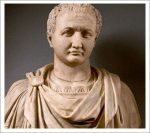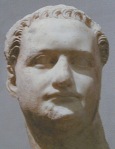 Piazza Navona lies in the heart of old Rome, surrounded by stunning Baroque buildings. It still follows the elongated horseshoe shape of Emperor Domitian’s Stadium in Ancient Rome, and has been a public space since the 1500s. It’s where Caravaggio killed a rival artist supposedly in a dispute over a tennis game. Pope Innocent X, who was Pope from 1644-1655, had a family residence on the Piazza, so he made sure the very best architects and artists of the time went to work there. This includes buildings by Bernini and his arch rival, Borromini. At its center of the piazza is yet another Bernini masterpiece from 1651, the “Fountain of Four Rivers”. As we’ve seen with Bernini’s previous work, baroque sculpture is really all about pushing the figure to its most dynamic position. Often, Bernini’s sculptures are like high-action snapshots, the figure frozen in a moment of intense action movement.
Piazza Navona lies in the heart of old Rome, surrounded by stunning Baroque buildings. It still follows the elongated horseshoe shape of Emperor Domitian’s Stadium in Ancient Rome, and has been a public space since the 1500s. It’s where Caravaggio killed a rival artist supposedly in a dispute over a tennis game. Pope Innocent X, who was Pope from 1644-1655, had a family residence on the Piazza, so he made sure the very best architects and artists of the time went to work there. This includes buildings by Bernini and his arch rival, Borromini. At its center of the piazza is yet another Bernini masterpiece from 1651, the “Fountain of Four Rivers”. As we’ve seen with Bernini’s previous work, baroque sculpture is really all about pushing the figure to its most dynamic position. Often, Bernini’s sculptures are like high-action snapshots, the figure frozen in a moment of intense action movement.
Commissioned by Pope Innocent X, the huge fountain depicts 4 mythological figures, representing what were known as the 4 major rivers in the world in the 1600s: the Ganges in Asia, the Danube in Europe, the Nile in Africa, and the Plate in the Americas. Each figure is surrounded by animals and plants that fit these locations, and function as allegories to the rivers. GANGES is large and relaxed, holding a large oar to represent the navigability of the river, which is broad and deep. DANUBE reaches back and touches a papal crest (which includes the keys of St. Peter), because the Danube is the closest of the great rivers to Rome. NILE has a piece of cloth covering his head, which symbolizes the unknown origins of the Nile ate the time. Finally, the PLATE is seen sitting on a pile of coins, symbolizing the riches that the Americas would bring Europe. The name Plate, or Rio del la Plata, is Spainish for River of Silver. The entire fountain supports a large ancient Egyptian obelisk, brought to Rome in ancient times and reassembled to fit here.
I tried to find an interesting Youtube video to show the fountain, and there are hundreds of horrible quality tourist videos. I did find this one though, an HD video from a guy savvy enough to film the entire Piazza early in the morning before the hoards arrive. It’s a little jittery and there’s some loud street sweepers in the background, but the visuals are wonderful. The video looks at the entire Piazza, including the 2 other fountains (also with designs by Bernini) and the historic buildings.
If you haven’t already done so, be sure to read the other posting on Bernini here and watch Simon Schama’s amazing “Power of Art” film. Much more to come on Bernini-











